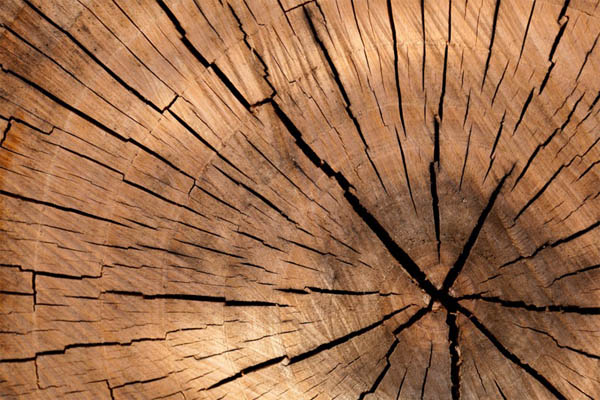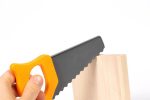How to Cut Wood Slices from Logs
Woodworking is a timeless craft, enabling individuals to transform a humble piece of wood into stunning art, furniture, and decor.
Among the foundational skills in woodworking is the ability to slice wood from logs, which serves as versatile raw material for a myriad of projects, whether you’re crafting rustic coasters or intricate scrollwork designs.
To begin your woodworking journey or infuse a natural touch into your creations, mastering how to cut wood slices from logs is paramount.
In this extensive guide, we’ll explore the step-by-step process of using a chainsaw blade to cut wood slices from logs, ensuring you make the most of each piece of wood and even repurpose scrap wood effectively.
With safety measures, tools, and creative possibilities at your disposal, you’ll be well-equipped to embark on woodworking projects that showcase the beauty of wood.
Cut Wood Slices from Logs With Chainsaw: Step-by-Step Guide
Step 1: Elevate the Log for Safety
Safety should always be the foremost concern when working with tools, especially those as powerful as saws.
Elevating the log off the ground ensures a stable and secure working surface.
A sawhorse or a purpose-built platform provides the necessary elevation while preventing the saw from striking the ground or causing unexpected kickbacks.
To achieve this, place the log horizontally on the sawhorse or platform. Ensure that the log is positioned securely and won’t shift during the cutting process.
Step 2: Choose the Right Saw
Choosing the right saw is a crucial decision that directly affects the quality of your wood slices, especially when it comes to cutting wood slices with a chainsaw.
While a miter saw and a band saw are the two primary options for this task, it’s worth noting that a chainsaw can also be used, albeit with the need for a higher level of expertise and stringent safety precautions.
- Miter Saw: Known for its precision in making accurate crosscuts, a miter saw is an excellent choice for cutting uniform wood slices. The circular blade, mounted on a pivoting arm, allows for angled cuts as well.
- Band Saw: A band saw features a continuous looped blade that facilitates intricate curved cuts. This is particularly advantageous when dealing with logs of irregular shapes.
- Chainsaw: While slightly more challenging to control, a chainsaw can be used for cutting wood slices. However, due to its power and the potential for kickbacks, it’s recommended for experienced users who prioritize safety.
Step 3: Measure and Mark the Log
Achieving precise and uniform wood slices begins with accurate measurements and markings.
Using a tape measure, determine the desired thickness for your wood slices.
Once decided, carefully mark the cutting lines on the tree log with a pencil or marker.
Take your time during this step, as the precision in marking directly impacts the quality of the end product.
Step 4: Cut the Log
With the tree log securely elevated and the cutting lines clearly marked, it’s time to make the cuts. Depending on the saw you’re using, follow these guidelines:
- Miter Saw: Align the marked cutting line with the saw blade. Ensure that the log is held firmly against the miter saw’s fence, then activate the saw and smoothly guide it through the log.
- Chainsaw: If you choose to cut wood slices with a chainsaw, proceed with caution. You can opt to cut freehand if you’re experienced, or you can fashion a jig to guide the chainsaw along the marked line. A jig increases precision and reduces the chances of uneven cuts. Keep the chainsaw chain above the jig to achieve the desired thickness of the cut.
Step 5: Sand the Wood Slices
After making the cuts, you may notice rough edges or surfaces on the wood slices. Sanding is essential to achieve a smooth and polished finish.
Use sandpaper with varying levels of coarseness to sand down imperfections and create a consistent surface.
Sanding not only enhances the appearance of the wood but also ensures that your wood slices are safe to handle.
Safety Precautions
Working with powerful tools requires utmost caution. Prioritize safety by adhering to these precautions:
- Protective Gear: Wear appropriate safety gear, including safety glasses, ear protection, gloves, and a long-sleeved shirt to shield your skin from debris.
- Chainsaw Precautions: If using a chainsaw, consider investing in chainsaw chaps or other protective clothing designed to reduce the risk of injury from potential kickbacks or accidents.
- Work Area: Maintain a clean and organized work area with sufficient lighting to clearly see your workspace and the markings on the log.
- Proper Technique: Follow manufacturer guidelines for your chainsaw and employ proper cutting techniques to minimize the risk of accidents.
Unlocking Creative Possibilities
Mastering the art of cutting wood slices from logs opens up a world of creative possibilities:
- Home Decor: Create stunning centerpieces, wall art, and table settings that infuse natural beauty into your living space.
- Woodworking Projects: Incorporate wood slices into your furniture designs, adding an organic and visually captivating element to your creations.
- Personalized Gifts: Craft one-of-a-kind gifts by engraving, painting, or etching designs onto wood slices.
- Jewelry: Design unique wooden jewelry pieces, from pendants to earrings, showcasing the intricate patterns and textures of the wood.
- Coasters and Trivets: Craft functional items like coasters and trivets that protect surfaces while adding a touch of rustic elegance.
Conclusion
Cutting wood slices from logs is a foundational skill in woodworking that offers a gateway to endless creative expressions.
From the choice of saw to the sanding process, each step contributes to the quality and beauty of your wood slices.
As you delve into this craft, always prioritize safety by donning the necessary protective gear and following proper techniques.
Remember, woodworking is not just about creating tangible pieces; it’s a journey that allows you to connect with the timeless beauty of nature and the art of craftsmanship.
So, elevate the log, choose the right saw, measure and mark with precision, make the cuts confidently, sand the slices to perfection, and let your woodworking endeavors flourish in ways you never thought possible.

Don Kerr spent many years honing his skills as a DIY woodworker. He finds immense joy in not only creating remarkable pieces but also in generously sharing his knowledge. Connect with him via group.



